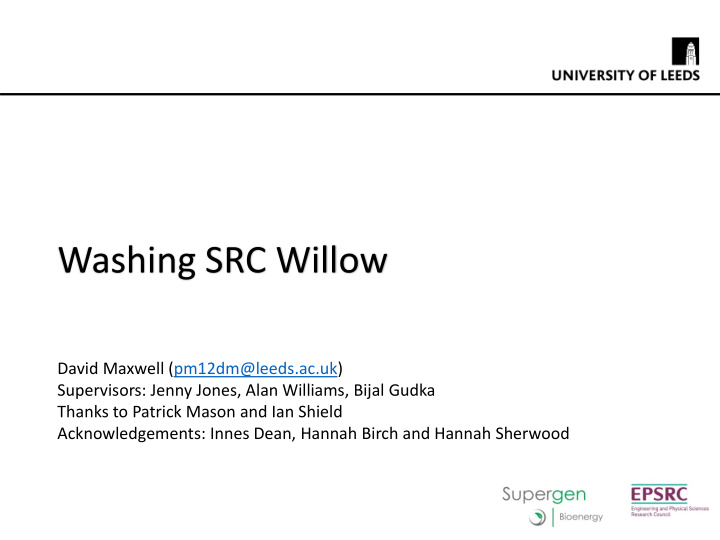



Washing SRC Willow David Maxwell (pm12dm@leeds.ac.uk) Supervisors: Jenny Jones, Alan Williams, Bijal Gudka Thanks to Patrick Mason and Ian Shield Acknowledgements: Innes Dean, Hannah Birch and Hannah Sherwood
Are Solid Fuels dated? • Increase in the number of solid fuel stoves in operation because of fashion trends • Conversion of coal power stations to biomass or co-firing • Developing world requirements for heating and cooking • One of the oldest technology forms Olive Torrefied Spruce Willow
The Problems with Biomass? Introducing a Tree Farm with Tree A and Tree B x Tree A Tree B
The Problems with Biomass? Just because they are on the same farm and will be blended to make one fuel source Doesn’t mean they are the same. x Tree A Tree B
The Problems with Biomass? Just because they are on the same farm and will be blended to make one fuel source Doesn’t mean they are the same. x Tree A Tree B
The Problems with Biomass? Just because they are on the same farm and will be blended to make one fuel source Doesn’t mean they are the same. x Slurry Containment Old Coal Mine Land Fill
The Problems with Biomass? Accumulation of elements within the biomass source Tree B
The Problems with Biomass? Tree B becomes our solid fuel for our stove Emissions of PM 1 can contain Inorganic elements such as Cu, Co, Zn, As, Mn, Pb and V
Washing- A potential Solution • Reduce the ash content of a fuel, this means less bottom ash post combustion and therefore prevents ash handling and disposal problems. • Remove harmful trace metals which can be emitted in PM 1 and become airborne. These trace metals can catalyse lung disease and cause lung cell denaturing. • Upgrade fuels by removing K and Ca and prevent boiler degradation from clinker and slagging effects.
Washing rig? Using a rock tumbler the willow chip was loaded with the water in a ratio of 1:2 by mass. Removal of the inorganic species is by three mechanisms: 1. Dirt suspension and settling into the water 2. Ionisation of salts 3. Abrasion of particles causing fragments to become suspended or settled in the water
Separate the phases out Leachate Biomass Fines
Mass Balance- Game of Cluedo
Biomass 20 Minute Unwashed Wash 0 20 Time Volatile Matter 82.48 82.13 (%db) Ash 1.65 1.37 Moisture (%AR) 14.80 46.70 C (%daf) 50.19 44.33 H 6.46 5.71 N 0.53 0.59 S 0.11 0.08 O 42.71 49.29
Biomass The table below expresses the amount of each species found in 1kg of fuel Unwashed 20 Minute Unwashed 20 Minute Wash Wash Ash (%db) 1.65 1.37 Ca (mg) 3800 3400 Zn 95.1 88.9 K 2270 2000 Cu 5.9 3.3 P 994 807 Cd 1.2 0.9 Mn 195 187 Pb N/A 1.8 Na 431 356 Ni 1.3 1.4 Fe 411 254 Ba 6.7 6.9 Al 287 201 Cr 0.8 1.2 Si 516 356 Mg 632 607 *All table values are expressed as mg/kg
Leachate 20 Minute Distilled 20 Minute Wash Water Wash Zn (mg/L) 41.2 Ca (mg/L) 3.2 4.18 Cu 0.49 K 1.5 350 Cd 0.105 P 0.01 49.1 Pb 0.018 Na 3.56 5.25 Ni 0.007 Mg 632 21.3 Ba 0.713 Cr 0.002
Dilution Pitot tube Tunnel flow metering 5.7 kW Waterford Gas sampling Stanley Oisin points multi-fuel stove Smoke Metre Thermocouples in and above bed Dekati impactors Balance GASMET FTIR exhaust gas Testo Gas analyser Analyser
Burning rate- Washed
Particulates PM emission factor for the unwashed fuel is 240mg/Nm 3 where as the washed fuel is 49mg/Nm 3 7 6 Emission Factor (mg/Nm3) 5 4 20 Min Wash Unwashed 3 2 1 0 Al S Cl K Ca Zn Ba
Conclusions • Washing will reduce the ash content of SRC willow chip when washed in distilled water • The washed willow post washing contains less trace metals and inorganics, the trace metals can become suspended in the leachate phase and inorganics are ionised and transfer from the willow chip into the leachate • The reduced ash content and increased homogeneity of the washed fuel means that during combustion the burning rate is more consistent and flaming combustion is maintained for longer. • The time period of pre-flaming smouldering is reduced when the fuel is washed. The decreased ash content means the mixture becomes flammable at a lower temperature. This is responsible for the decreased particulate emission factor. • Trace metal emissions are lower as well as inorganic emissions.
Acknowledgements I would like to acknowledge the contributions of Innes Dean, Hannah Birch and Hannah Sherwood for their participation in the project. I would also like to thank EPSRC, the Bioenergy CDT at Leeds University and Supergen for their funding support.
Thank you Any question? David Maxwell (pm12dm@leeds.ac.uk)
Recommend
More recommend